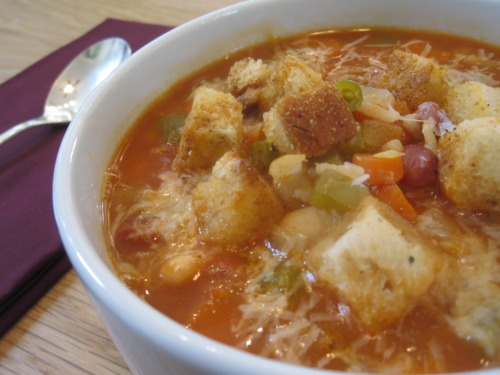I hope that in writing my recipes I come across as flexible. The last thing I would ever want to imply to my readers is that there is one correct way to cook something, or even worse, that following a recipe to the letter is how one yields a good result. Cooking (unlike baking) simply does not work that way.
The most effective way to look at a recipe is to read between the lines for the technique. A technique can be very straightforward, like sauteing or grilling, or more multifaceted, like soup making.
The best advice: start with good-quality recipes from trusted sources. Read through a recipe and its cooking instructions completely before beginning. Think about why things are done the way they are. Using this soup recipe as an example, why saute some of the vegetables first and then add others later? Does it really make a difference?
The vegetables this recipe begins with (onion, carrot & celery) are classic aromatics. These vegetables are a part of thousands of classical recipes and they benefit from cooking, sauteing in particular, because they need direct heat to release their natural sugars. Additionally, these vegetables cannot really be overcooked in a soup preparation because the longer they simmer in the liquid, the more flavorful the broth will become, especially after they have been sauteed.
A soup recipe like this one will yield a very different result that a soup recipe where everything is thrown into a pot with the liquid and simmered. One is not inherently better than the other, but the techniques are entirely different.
All of that said, the most adaptable part of a recipe are the ingredients. No need to get hung up at the grocery store if the asparagus is $6 a pound or mushrooms make you gag or the green beans look like they spent a month in the truck on the way there. Be flexible.
I did my best to write this recipe in a way that will encourage flexibility while highlighting technique. So get out there and make your own unique minestrone soup!
Minestrone Soup:
1 C. dried beans, soaked overnight, or 1 can of beans, rinsed. Navy beans, red beans, fresh cranberry beans, kidney beans, garbanzos, etc.
A few Tbsp. of fat. Oil, butter, or both OR the fat rendered from a few thick pieces of chopped bacon, pancetta, or sausage
3 C. mixed aromatic vegetables, small dice: leek, onion, shallot, garlic, celery, fennel, carrot, mushrooms – choose a few (or more) that you like.
A few cups of tomatoes – canned, boxed, chopped fresh tomatoes, roasted cherry tomatoes – what sounds good to you?
About 6 C. liquid – water, chicken broth, a little wine (not more that 1 cup), or a combination?
Herbs – bay leaf, rosemary, thyme, basil leaves, oregano, marjoram, lavender?
Grain – Rice, pasta, barley, farro, middle eastern couscous, quinoa, etc.
Additional vegetables to be added near the end of cooking – green beans, cauliflower, broccoli, zucchini, asparagus, kale, spinach, etc. These are the vegetables that you want to retain their texture and bright color in the soup, hence their addition near the end of cooking. Choose a few of your favorites or pick something that sounds particularly delicious with the other ingredients you’ve chosen.
Technique:
In a large stockpot over medium heat, add your fat. If using bacon, etc., cook it until crisp to release the fat and then remove it from the pan with a slotted spoon and set aside.
Add your aromatic vegetables to the fat, seasoning them generously with salt and pepper. Let them cook for about 10 minutes, stirring occasionally, until they are starting to get some color.
Add your tomatoes, your cooking liquid(s), herbs, and the soaked beans if using. I don’t recommend adding canned beans at this time, as they will get too soft.
Bring to a boil and reduce to a simmer. Cook, partially covered, for 30 minutes or up to 90 minutes, until your beans are just tender.
Next, add your grain. The time needed for cooking at this point will vary depending on the grain you choose. Quinoa or rice will cook more quickly, farro or barley will take more time. Again, simmer until your grain is just tender.
Lastly, add your canned beans if using and any additional vegetables you desire. These should be cut into bite sized pieces and should cook for under 10 minutes or until just barely tender.
Return your bacon or other meat to the pot if using. Season the soup to taste with salt and pepper. Add more fresh herbs is you desire.
Serve with bread, croutons, Parmigiano-Reggiano cheese, or a spoonful of pesto on top.


 RSS - Posts
RSS - Posts